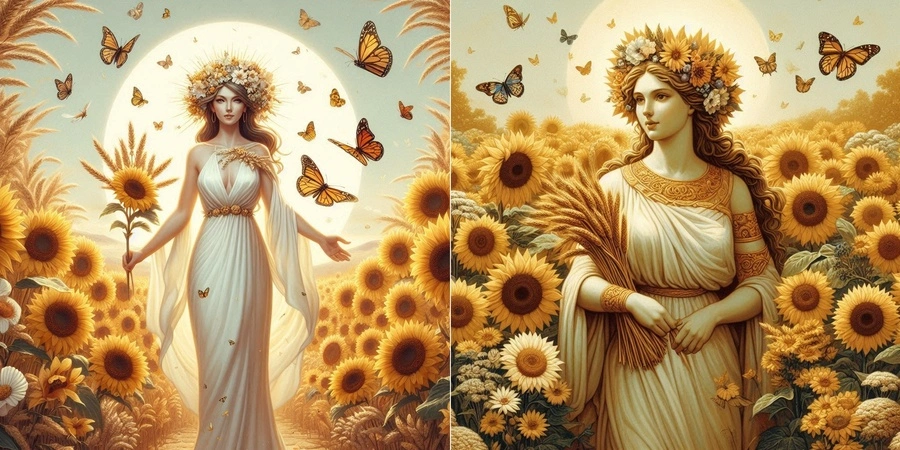
Demeter, the Greek goddess of agriculture, harvest, and fertility, was one of the most important figures in ancient Greek mythology. She is often depicted as a maternal figure, nurturing the earth and its creatures, and bringing forth bountiful harvests.
Demeter is one of the twelve Olympian gods and goddesses, and she was highly revered in ancient Greece. She was often worshiped as the goddess of agriculture and was believed to have the power to ensure the success of crops and the fertility of the land.
Many ancient Greeks believed that Demeter was responsible for the seasons, and her presence was especially important during the harvest season, when the fruits of the earth were gathered and celebrated.
The Story of Demeter
Demeter’s origins lie in the primordial world of the Titans. Daughter of Cronus, the king of the Titans, and Rhea, she was born amidst a time of great upheaval. Fearing a prophecy that his children would overthrow him, Cronus swallowed them whole one by one. Demeter, along with her siblings, endured a dark and cramped existence within their father’s belly. However, Zeus, the youngest, eventually managed to overthrow Cronus and free his siblings.
Emerging from this ordeal, Demeter stepped onto the earth, a being of immense power and purpose. It was she who bestowed upon humanity the knowledge of agriculture. With gentle hands, she taught people how to cultivate the soil, sow seeds, and reap the fruits of their labor. Golden wheat fields flourished under her watchful gaze, and humanity thrived under the bounty of her harvest.
Demeter’s influence extended beyond Greece. The Romans worshipped a similar goddess named Ceres, whose mythology mirrored Demeter’s. Additionally, Demeter’s agricultural role found resonance in various cultures around the Mediterranean, highlighting the universality of her representation of fertility and the harvest.

One of the most famous myths surrounding Demeter is the story of her daughter, Persephone. According to the myth, Persephone was kidnapped by Hades and taken to the underworld to be his queen. Demeter was devastated by the loss of her daughter, and searched the world in vain for her.
During her search, Demeter neglected her duties as the goddess of agriculture, causing crops to wither and die. The other gods intervened, and Hermes was sent to the underworld to negotiate with Hades for Persephone’s release.
Hades agreed to let Persephone go, but only if she had not eaten anything in the underworld. However, Persephone had eaten six pomegranate seeds, which meant that she had to spend six months of the year in the underworld as Hades’ queen.
When Persephone returned to the surface, Demeter was overjoyed and the earth became fertile again. However, when Persephone returned to the underworld, Demeter grieved and the earth became barren once more.
10 Myths and Facts about Demeter
- Demeter and the Four Seasons: Demeter’s grief over the abduction of her daughter Persephone by Hades is central to the myth explaining the changing seasons. When Persephone is with Hades in the underworld, Demeter’s sorrow causes winter, and her joy upon Persephone’s return heralds spring and the renewal of life.
- The Grain Mother and Poseidon’s Pursuit: Demeter wasn’t always the serene figure associated with agriculture. One myth tells the tale of Poseidon, the god of the sea, relentlessly pursuing Demeter. To escape his advances, Demeter transformed herself into a mare, hoping to blend in with a herd of horses. However, Poseidon, ever resourceful, shapeshifted into a stallion and impregnated her. From this unlikely union came Despoina, a goddess representing fertility, and Arion, a magical talking horse.
- Demeter and the Eleusinian Mysteries: The Eleusinian Mysteries were a prominent secret cult in ancient Greece. While the exact details remain shrouded in secrecy, Demeter and Persephone played central roles. Initiation into the mysteries promised initiates a blessed afterlife, suggesting Demeter held a deeper connection to the cycle of life, death, and rebirth than simply overseeing the harvest.
- Demeter, the Lawgiver: Demeter’s title “Thesmophoros” translates to “lawgiver.” She wasn’t just concerned with the physical sustenance of humanity but also with the laws and social order that ensured a harmonious society. This aspect connects her to her brother Zeus, the king of the gods, who was also associated with law and justice.
- Demeter and the Megaera Curse: In some lesser-known myths, Demeter is associated with the wrathful aspect of the Furies, particularly Megaera. In these versions, Demeter curses those who violate sacred laws or commit acts of injustice, unleashing a terrible vengeance upon them. This darker side adds another dimension to the goddess’s multifaceted character.
- Demeter’s Epithets: Demeter had numerous epithets, each highlighting a specific aspect of her domain. “Chthonia” connected her to the underworld and the cycle of life and death. “Karpophoros” emphasized her role as the bringer of fruit. “Thermosphoros” linked her to the warmth of summer and bountiful harvests. These epithets offer valuable insights into the diverse aspects of Demeter’s power.
- Demeter and the Minotaur: A lesser-known Cretan myth links Demeter to the monstrous Minotaur. According to some versions, Demeter visited Crete, where she had a tryst with King Minos. From this union, some myths claim, came the Minotaur, a creature with the head of a bull and the body of a man.
- Demeter Festivals: Several festivals throughout the year honored Demeter. The Thesmophoria, a women-only festival, celebrated fertility, marriage, and Demeter’s role as a lawgiver. The Thesmophoria included rituals of obscenity and jest, believed to promote agricultural fertility. Additionally, the Eleusinian Mysteries, held annually, were a major religious event focused on themes of death and rebirth.
- Demeter and Triptolemus: Demeter taught Triptolemus the art of agriculture and entrusted him with spreading her gift of farming throughout the world. Triptolemus became her loyal follower and played a crucial role in promoting agricultural practices among humanity.
- Demeter’s Sanctuary at Eleusis: Demeter found solace at Eleusis during her search for Persephone. In gratitude for their hospitality, she revealed the secrets of agriculture and the Eleusinian Mysteries to the people of Eleusis, establishing her sanctuary there.

The Symbols of Demeter
1. The Golden Sheaf of Wheat: The most prominent symbol of Demeter is undoubtedly the golden sheaf of wheat. It represents the bounty of the harvest, the culmination of the agricultural cycle she oversees. This symbol highlights Demeter’s role as the provider, the one who ensures humanity’s sustenance. Additionally, the golden color evokes the warmth and life-giving power of the sun, essential for the growth of crops.
2. The Cornucopia, Horn of Plenty: Often depicted in Demeter’s hands, the cornucopia is a horn overflowing with flowers, fruits, and grains. It symbolizes abundance, fertility, and the ever-flowing generosity of the earth. This symbol emphasizes Demeter’s role not just in the harvest itself but in the constant cycle of renewal and growth. The cornucopia also carries connotations of prosperity and divine blessings.
3. The Poppy: The delicate poppy flower, often associated with sleep and forgetfulness, might seem an unusual choice for Demeter. However, this seemingly contradictory symbol holds deeper meaning. In some myths, the poppy is linked to Persephone’s time spent in the underworld, offering Demeter a temporary respite from her grief. It embodies the bittersweet acceptance of loss and the passage of time, reminding us that even in sorrow, there is a time for rest and renewal.
4. The Torch: Demeter’s relentless search for her abducted daughter, Persephone, is a central theme in her mythology. The torch she carries during this search symbolizes her unwavering hope and fierce determination. It represents the light of knowledge, as Demeter seeks to uncover the truth behind Persephone’s disappearance. Additionally, the torch carries connotations of protection, as Demeter strives to keep her daughter safe from harm.
5. The Pig: The pig, a sacrificial animal in ancient Greek agricultural rituals, finds its place among Demeter’s symbols. This seemingly mundane creature represents the offering made to the goddess in exchange for a bountiful harvest. Additionally, the pig’s role in plowing the earth connects it to the very foundation of agriculture. In some versions, the pig is also associated with the Eleusinian Mysteries, further solidifying its link to Demeter’s domain.
6. The Chariot Drawn by Dragons: In some myths, Demeter is depicted riding a chariot pulled by winged dragons. This majestic symbol evokes Demeter’s power and authority over the natural world. The dragons, often associated with fire and transformation, suggest Demeter’s ability to bring about change and renewal. The act of riding the chariot also signifies Demeter’s journey across the land, ensuring the spread of agricultural knowledge and the blessings of a bountiful harvest.
7. The Veil: Demeter, during the period of Persephone’s absence, is often depicted wearing a veil. This symbol embodies her grief and the sense of mourning that hangs over the land. The veil also carries connotations of mystery, reflecting the secrets of the underworld where Persephone resides. The act of lifting the veil, then, signifies the return of spring, the joy of reunion, and the unveiling of new life.
| Demeter has been a powerful symbol throughout history. In ancient Greece, she was depicted as a mature woman, often crowned with wheat and carrying a sheaf of grain. Sculptures and paintings portrayed her as a benevolent figure, radiating the warmth and nurturing qualities of the earth mother. |